American Journal of Computational Mathematics
Vol.2 No.4(2012), Article ID:25494,5 pages DOI:10.4236/ajcm.2012.24036
Nonconforming H1-Galerkin Mixed Finite Element Method for Pseudo-Hyperbolic Equations
1School of Mathematics and Statistics, Xuchang University, Xuchang, China
2Department of Mathematics, Henan Institute of Science and Technology, Xinxiang, China
Email: *yadzhang@126.com
Received July 22, 2012; revised October 1, 2012; accepted October 17, 2012
Keywords: Pseudo-Hyperbolic Equation; Nonconforming; H1-Galerkin Mixed Finite Element; Error Estimate
ABSTRACT
Based on H1-Galerkin mixed finite element method with nonconforming quasi-Wilson element, a numerical approximate scheme is established for pseudo-hyperbolic equations under arbitrary quadrilateral meshes. The corresponding optimal order error estimate is derived by the interpolation technique instead of the generalized elliptic projection which is necessary for classical error estimates of finite element analysis.
1. Introduction
Consider the following initial-boundary value problem of pseudo-hyperbolic equation
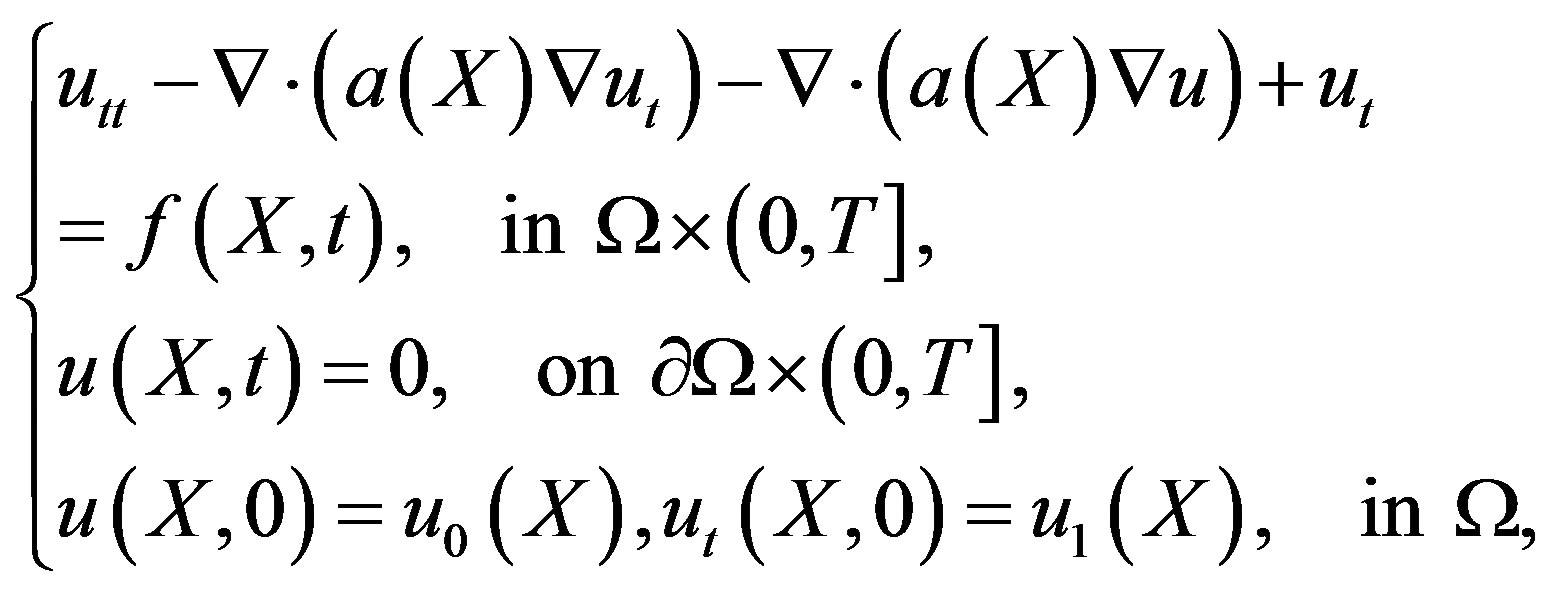 (1)
(1)
where 
 is bounded convex polygonal domain in
is bounded convex polygonal domain in 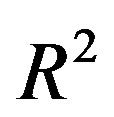 with Lipschitz continuous boundary
with Lipschitz continuous boundary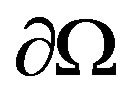 .
.
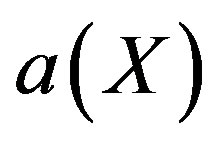 is smooth function with bounded derivatives,
is smooth function with bounded derivatives,
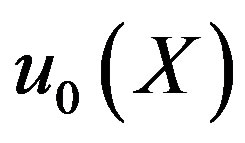 ,
, 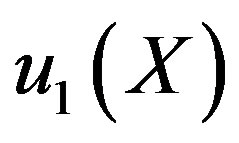 and f are given functions, and
and f are given functions, and
 for positive constants
for positive constants  and
and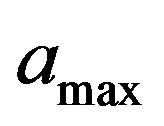 .
.
The pseudo-hyperbolic equation is a high-order partial differential system with mixed partial derivative with respect to time and space, which describe heat and mass transfer, reaction-diffusion and nerve conduction, and other physical phenomena. This model was proposed by Nagumo et al. [1]. Wan and Liu [2] have given some results about the asymptotic behavior of solutions for this problem. Guo and Rui [3] used two least-squares Galerkin finite element schemes to solve pseudo-hyperbolic equations.
On the other hand, H1-Galerkin mixed finite element method (see [4]) has been under rapid progress recently since this method has the following advantages over classical mixed finite element method. The method allows the approximation spaces to be polynomial spaces with different orders without LBB consistency condition and there is no requirement of the quasi-uniform assumption on the meshes. For example, Pani [4,5] proposed an H1-Galerkin mixed finite element procedure to deal with parabolic partial differential equations and parabolic partial integro-differential equations, respectively. Liu and Li [6,7] applied this method to deal with pseudohyperbolic equations and fourth-order heavy damping wave equation. Further, Shi and Wang [8] investigated this method for integro-differential equation of parabolic type with nonconforming finite elements including the ones studied in [9,10].
It is well-known that the convergence behavior of the well-known nonconforming Wilson element is much better than that of conforming bilinear element. So it is widely used in engineering computations. However, it is only convergent for rectangular and parallelogram meshes. The convergence for arbitrary quadrilateral meshes can not be ensured since it passes neither Irons Patch Test [11] nor General Patch Test [12]. In order to extend this element to arbitrary quadrilateral meshes, various improved methods have been developed in [13-24]. In particular, [19-24] generalized the results mentioned above and constructed a class of Quasi-Wilson elements which are convergent to the second order elliptic problem for narrow quadrilateral meshes [23].
In the present work, we will focus on H1-Galerkin nonconforming mixed finite element approximation to problem (1) under arbitrary quadrilateral meshes. We firstly prove the existence and uniqueness of the solution for semi-discrete scheme. Then, based on a very special property of the quasi-Wilson element i.e. the consistency error is one order higher than interpolation error, we deduce the optimal order error estimates for semidiscrete scheme directly without using the generalized elliptic projection which is a indispensable tool in the tradition finite element methods.
This paper is arranged as follows. In Section 2, we briefly introduce the construction of nonconforming mixed finite element. In section III, we will discuss the H1-Galerkin mixed finite element scheme for pseudohyperbolic equations. At last, the corresponding optimal order error estimates are obtained for semi-discrete scheme.
2. Construction of Nonconforming Mixed Finite Element
Assume  to be the reference element in the
to be the reference element in the  plane with vertices
plane with vertices
 and
and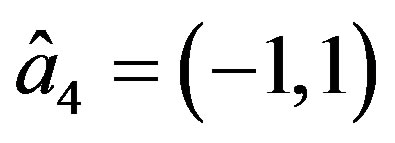 .
.
Let  and
and 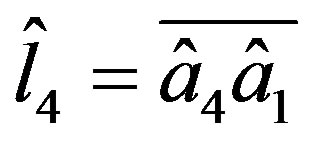 be the four edges of
be the four edges of .
.
We define the finite elements  by
by




where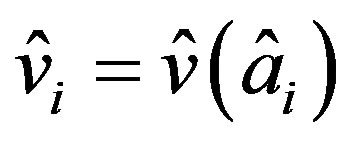 ,
, 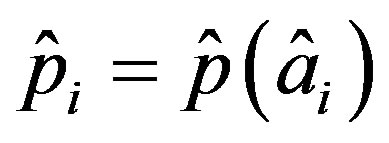 ,
,  ,
,



and

When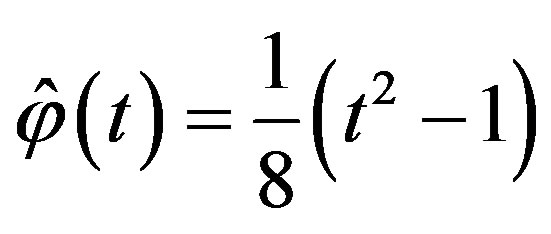 , it is the so-called Wilson element.
, it is the so-called Wilson element.
The interpolations defined above are properly posed and the interpolation functions can be expressed as

and

Given a convex polygonal domain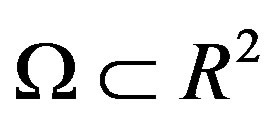 , Let
, Let
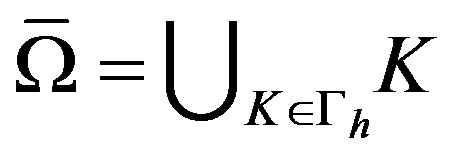 be a decomposition of
be a decomposition of  such that
such that 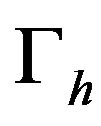
satisfies the regularity assumption [11], where K denotes a convex quadrilateral with vertices
 ,
, 
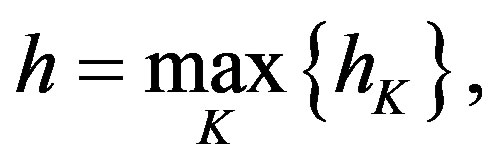 is the diameter of the finite element K.
is the diameter of the finite element K.
Then there exists a invertible mapping 

The associated finite element space  and
and 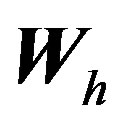 are defined as
are defined as

and

Then for all we define the interpolation operators
we define the interpolation operators 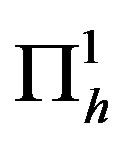 and
and 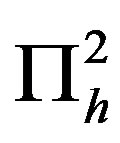 by
by

and


Let 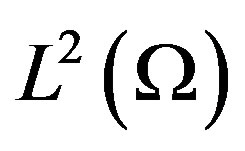 be the set of square integrable functions on
be the set of square integrable functions on  and
and 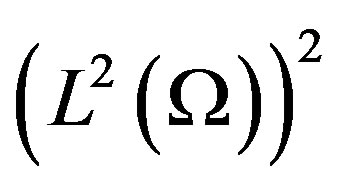 the space of two dimensional vectors which have all components in
the space of two dimensional vectors which have all components in  with its norm
with its norm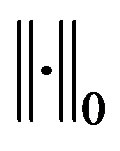 . Let
. Let 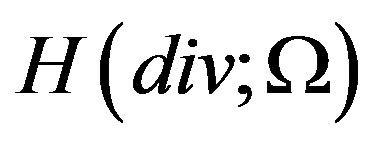 be the space of vectors in
be the space of vectors in
 which has divergence in
which has divergence in 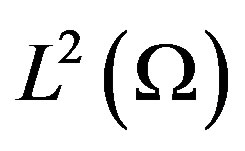 with norm
with norm 
 denotes the
denotes the 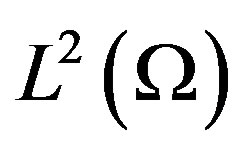 inner product. For our subsequent use, we also use the standard sobolve space
inner product. For our subsequent use, we also use the standard sobolve space  with a norm
with a norm 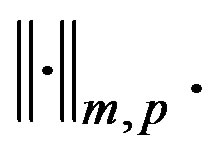 Especially for
Especially for , we denote
, we denote  and
and
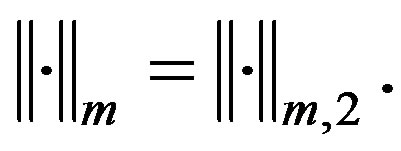
Throughout this paper, C denotes a general positive constant which is independent of h.
3. Nonconforming H1-Galerkin Mixed Finite Element Method for the Semi-Discrete Scheme
Let 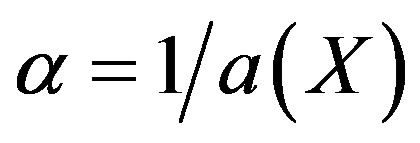 and
and , then the corresponding weak formulation is: Find
, then the corresponding weak formulation is: Find  , such that
, such that
 (2)
(2)
The corresponding semi-discrete finite element procedure is: Find , such that
, such that
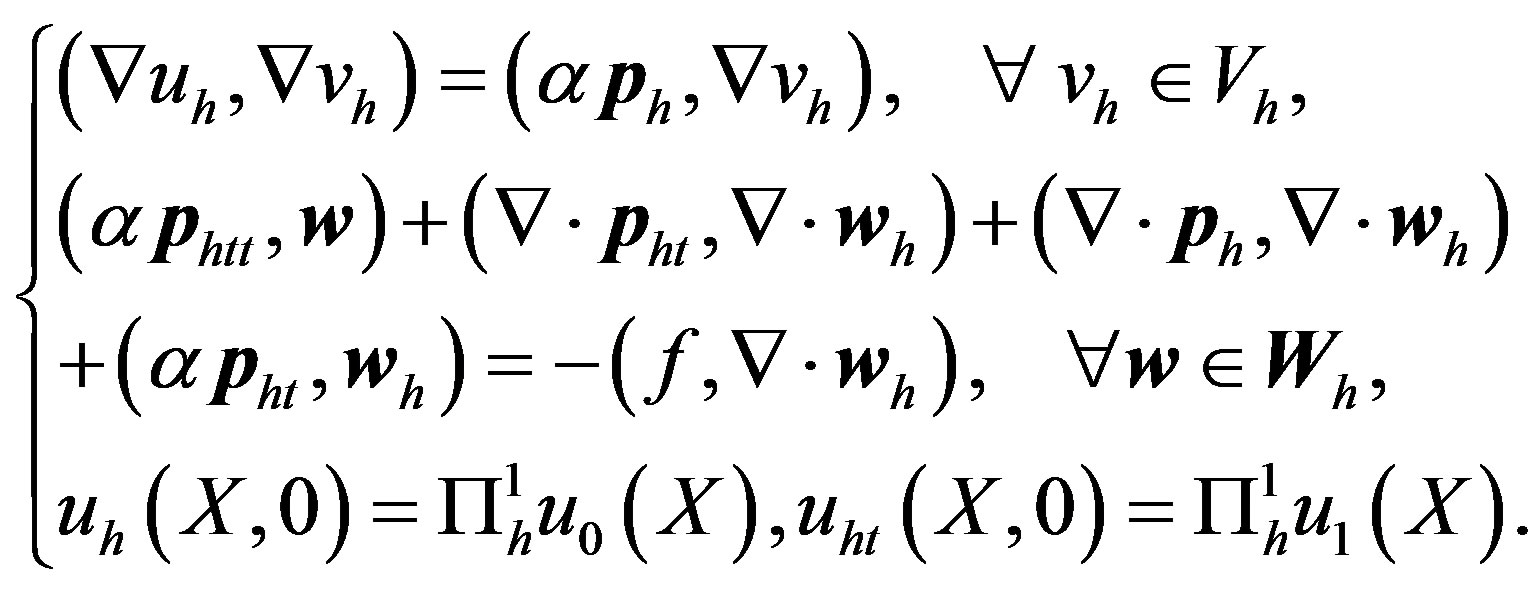 (3)
(3)
For all , we define
, we define
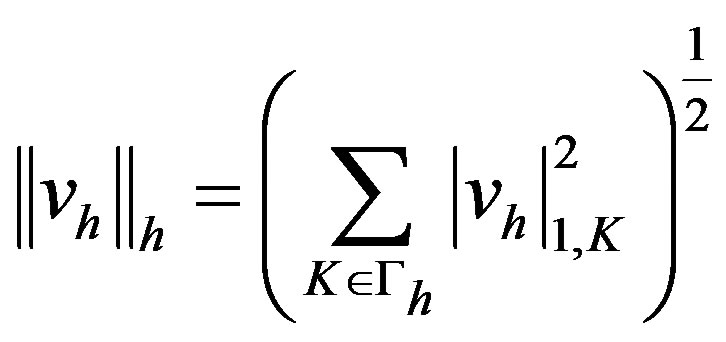
and

It is easy to see that 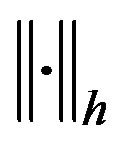 and
and 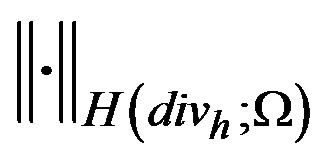 are norms of
are norms of
 and
and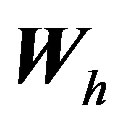 , respectively.
, respectively.
Theorem 1. Problem (3) has a unique solution.
Proof. Let 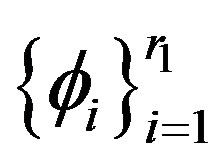 and
and 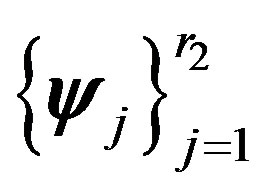 the basis of
the basis of  and
and
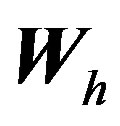 . Suppose that
. Suppose that

then (3) can be written as
 (4)
(4)
where




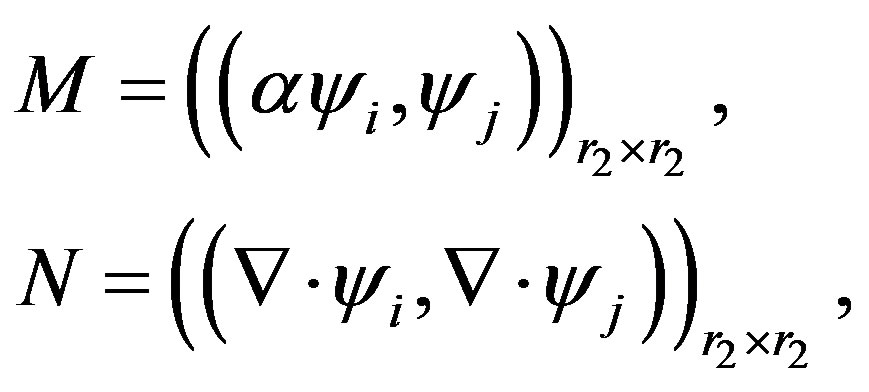

Sine (4) gives a system of nonlinear ordinary differential equations (ODEs) for the vector function 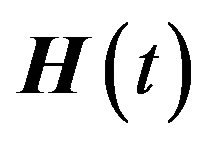 and
and , by the assumptions on
, by the assumptions on 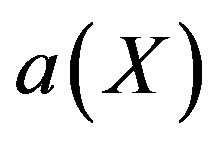 and the theory of ODEs, it follows that
and the theory of ODEs, it follows that 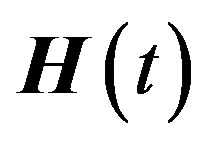 and
and 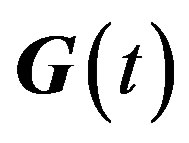 has the unique solution for
has the unique solution for  (see [25]). Therefore the proof is complete.
(see [25]). Therefore the proof is complete.
4. Error Estimates
In order to get the error estimates the following lemma which will play an important role in our analysis and can be found in [24].
Lemma 1. For all , then there holds
, then there holds

where  denotes the outward unit normal vector to
denotes the outward unit normal vector to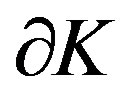 .
.
Now, we will state the following main result of this paper.
Theorem 2. Suppose that  and
and  be the solutions of the (2) and (3), respectively,
be the solutions of the (2) and (3), respectively,
 ,
,  and
and
 , then we have
, then we have
 (5)
(5)
and
 (6)
(6)
where
 .
.
Proof. Let 

It is easy to see that for all , there hold the following error equations
, there hold the following error equations
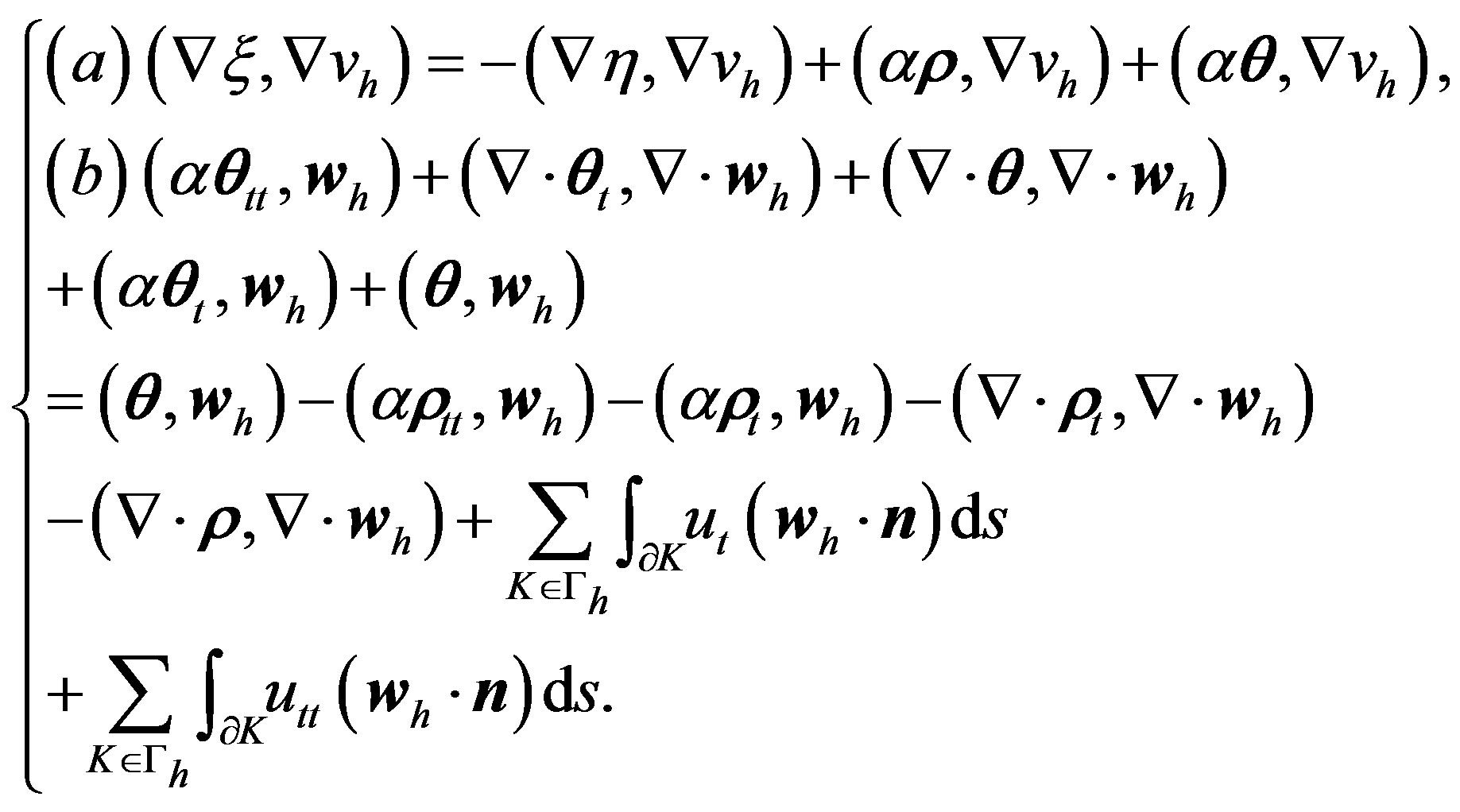 (7)
(7)
Choosing  in (7(a)) and using the CauchySchwartz’s inequality yields
in (7(a)) and using the CauchySchwartz’s inequality yields
 (8)
(8)
Further, choosing 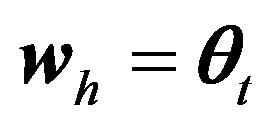 in (7(b)) leads to
in (7(b)) leads to
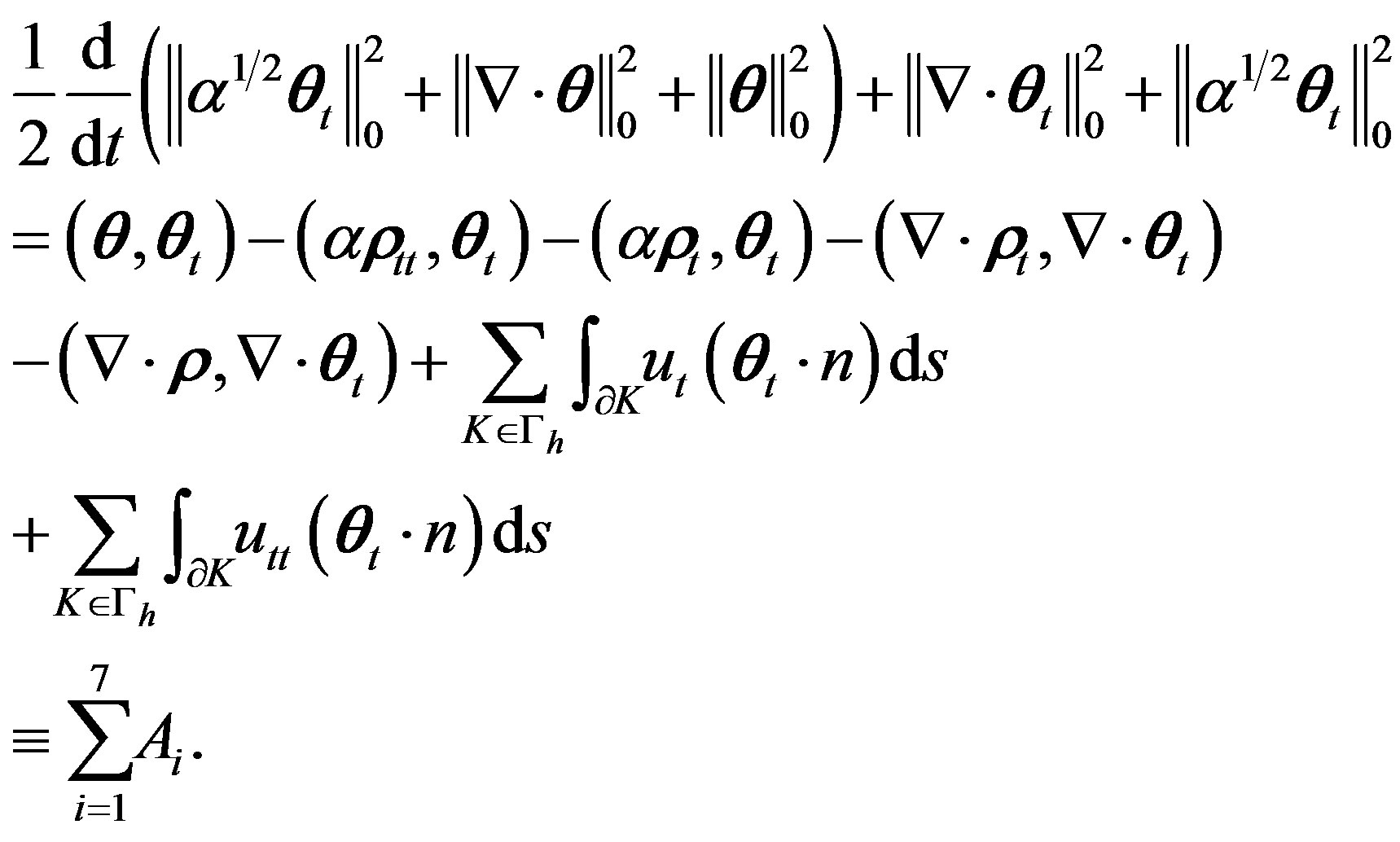 (9)
(9)
For the right side of (9), applying  -Young’s inequality and noting that
-Young’s inequality and noting that  is a smooth function with bounded derivatives, we get
is a smooth function with bounded derivatives, we get
 (10)
(10)
 (11)
(11)
By Lemma 1 and  -Young’s inequality, we have
-Young’s inequality, we have
 (12)
(12)
Choosing small  and combining (9)-(12), we can derive
and combining (9)-(12), we can derive
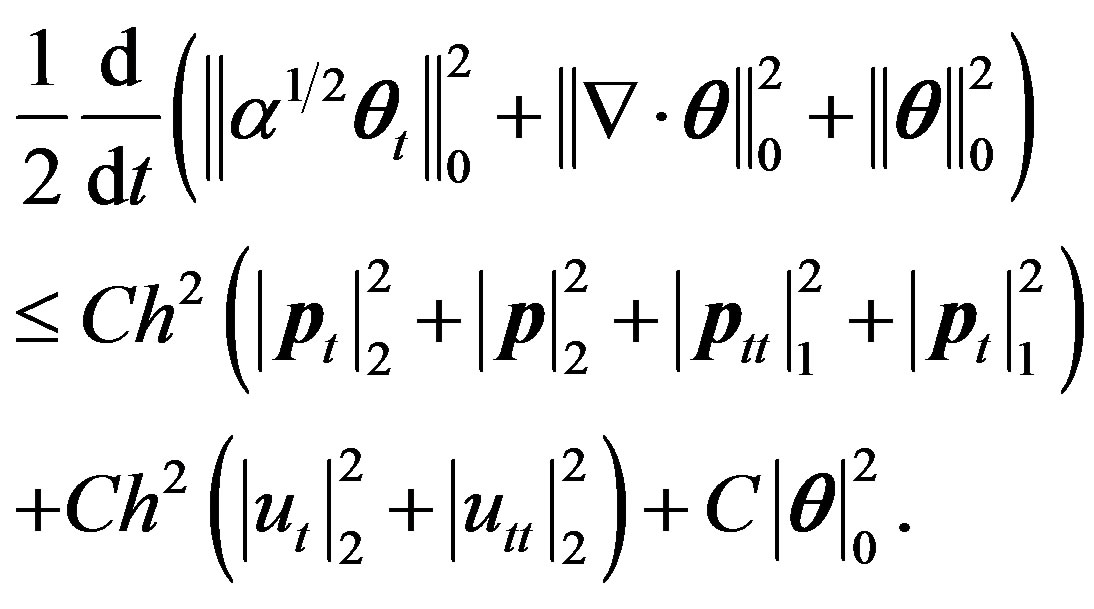 (13)
(13)
Integrating the both sides of (13) with respect to time from 0 to t, by Gronwall’s lemma and noting  , we obtain
, we obtain
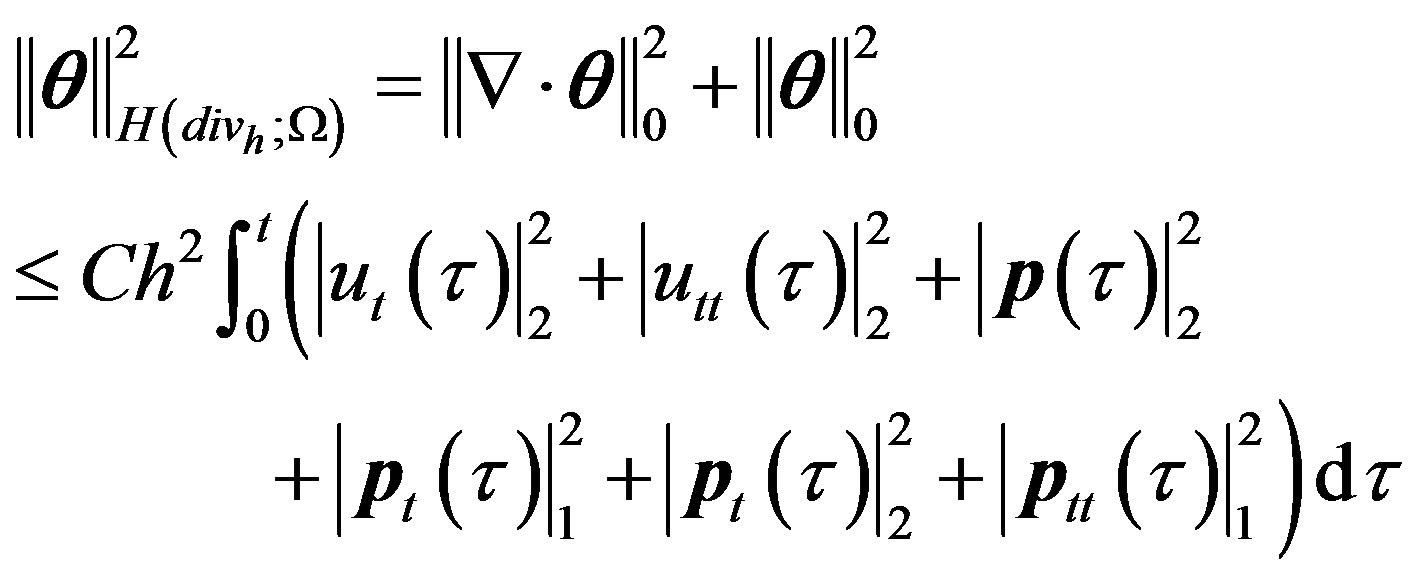 (14)
(14)
together with (8), there yields
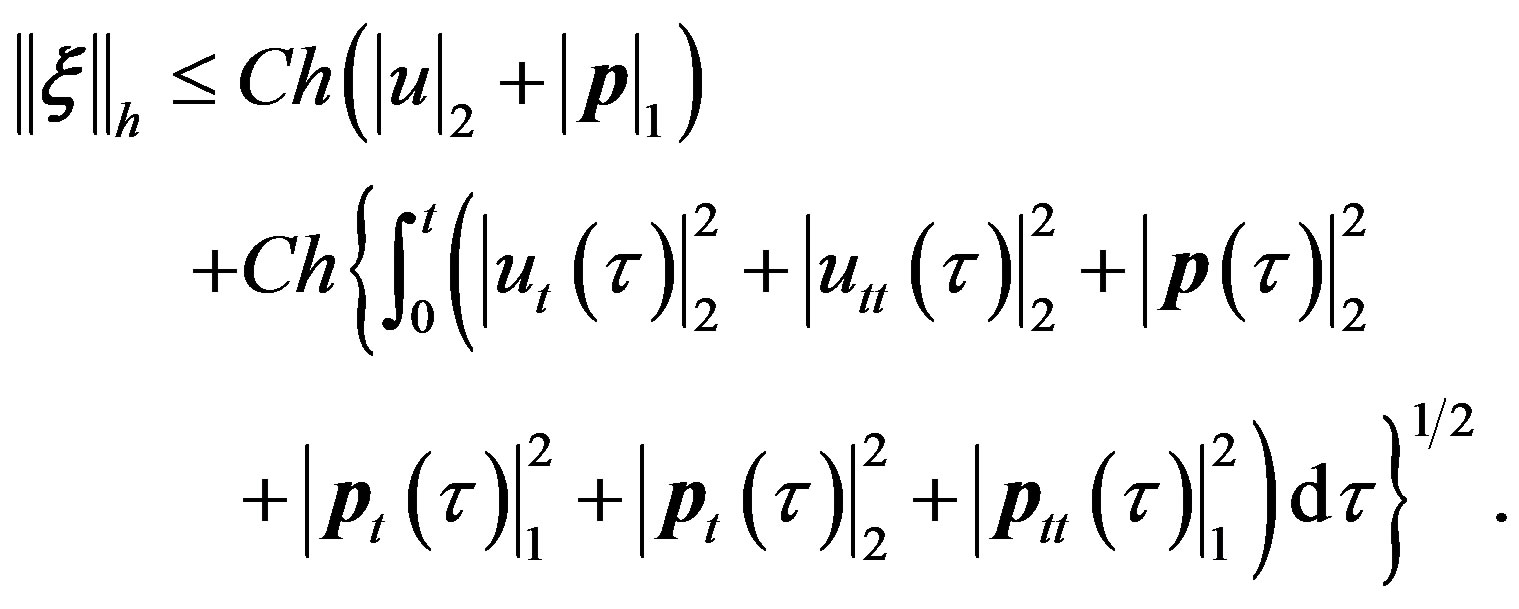 (15)
(15)
Finally, by use of the triangle inequality, (14) and (15), we get (5) and (6). The proof is completed.
5. Acknowledgements
This research is supported by National Natural Science Foundation of China (Grant No.10971203); Tianyuan Mathematics Foundation of the National Natural Science Foundation of China (Grant No.11026154) and the Natural Science Foundation of the Education Department of Henan Province (Grant Nos.2010A110018; 2011A110020).
REFERENCES
- J. Nagumo, S. Arimoto and S. Yoshizawa, “An Active Pulse Transmission Line Simulating Nerve Axon,” Proceedings of the Institute of Radio Engineers, Vol. 50, 1965, pp. 91-102.
- W. M. Wan and Y. C. Liu, “Long Time Behaviors of Solutions for Initial Boundary Value Problem of PseudoHyperbolic Equations,” Acta Mathematicae Applicatae Sinica, Vol. 22, No. 2, 1999, pp. 311-355.
- H. Guo and H. X. Rui, “Least-Squares Galerkin Procedures for Pseudo-Hyperbolic Equations,” Applied Mathematics and Computation, Vol. 189, 2007, pp. 425-439. doi:10.1016/j.amc.2006.11.094
- A. K. Pani, “An H1-Galerkin Mixed Finite Element Methods for Parabolic Partial Differential Equations,” SIAM Journal on Numerical Analysis, Vol. 35, No. 2, 1998, pp. 721-727. doi:10.1137/S0036142995280808
- A. K. Pani and G. Fairweather, “H1-Galerkin Mixed Finite Element Methods for Parabolic Parial Integro-Differential Equations,” IMA Journal of Numerical Analysis, Vol. 22, No. 2, 2002, pp. 231-252. doi:10.1093/imanum/22.2.231
- Y. Liu and H. Li, “H1-Galerkin Mixed Finite Element Methods for Pseudo-Hyperbolic Equations,” Applied Mathematics and Computation, Vol. 212, No. 2, 2009, pp. 446-457. doi:10.1016/j.amc.2009.02.039
- Y. Liu and H. Li, “A New Mixed Finite Element Method for Fourth-Order Heavy Damping Wave Equation,” Mathematica Numerica Sinica, Vol. 32, No. 2, 2010, pp. 157-170.
- D. Y. Shi and H. H. Wang, “An H1-Galerkin Nonconforming Mxied Finite Elment Method for Integro-Differential Equation of Parabolic Type,” Journal of Mathematical Research and Exposition, Vol. 29, No. 5, 2009, pp. 871-881.
- D. Y. Shi, S. P. Mao and S. C. Chen, “An Anisotropic Nonconforming Finite Element with Some Superconvergence Results,” Journal of Computational Mathematics, Vol. 23, No. 3, 2005, pp. 261-274.
- Q. Lin, L. Tobiska and A. H. Zhou, “Super Convergence and Extrapolation of Non-Conforming Low Order Finite Elements Applied to the Possion Equation,” IMA Journal of Numerical Analysis, Vol. 25, No. 1, 2005, pp. 160-181. doi:10.1093/imanum/drh008
- P. G. Ciarlet, “The Finite Element Method for Elliptic Problem,” Northe-Holland, Amsterdam, 1978.
- F. Stummel, “The Generalized Patch Test,” SIAM Journal on Numerical Analysis, Vol. 16, No. 3, 1979, pp. 449-471. doi:10.1137/0716037
- E. L. Wachspress, “Incompatible Basis Function,” International Journal for Numerical Methods in Engineering, Vol. 12, 1978, pp. 589-595. doi:10.1002/nme.1620120404
- Z. C. Shi, “A Convergence Condition for the Quadrilateral Wilson Element,” Numerische Mathematik, Vol. 44, No. 3, 1984, pp. 349-363. doi:10.1007/BF01405567
- J. S. Jiang and X. L. Cheng, “A Conforming Element like Wilson’s for Second Order Problems,” Journal of Computational Mathematics, Vol. 14, No. 3, 1992, pp. 274- 278.
- Y. Q. Long and Y. Xu, “Generalized Conforming Quadrilateral Membrance Element of Shecht,” Mathematica Numerica Sinica, Vol. 4, 1989, pp. 73-79.
- D. Y. Shi and S. C. Chen, “A kind of Improved Wilson Arbitrary Quadrilateral Elements,” Numerical Mathematics. A Journal of Chinese Universities, Vol. 16 No. 2, 1994, pp. 161-167.
- D. Y. Shi and S. C. Chen, “A Class of Nonconforming Arbitrary Quadrilateral Elements,” Journal of Applied Mathematics of Chinese Universities, Vol. 11, No. 2, 1996, pp. 231-238.
- D. Y. Shi, “Research on Nonconforming Finite Element Problems,” Ph.D. Thesis, Xi’an Jiaotong University, Xi’an, 1997.
- R. L. Taylor, P. J. Beresford and E. L. Wilson, “A Nonconforming Element for Stress Analysis,” International Journal for Numerical Methods in Engineering, Vol. 10, No. 6, 1980, pp. 1211-1219. doi:10.1002/nme.1620100602
- P. Lesaint and M. Zlamal, “Convergence for the Nonconforming Wilson Element for Arbitrary Quadrilateral Meshes,” Numerische Mathematik, Vol. 36, No. 1, 1980, pp. 33-52. doi:10.1007/BF01395987
- S. C. Chen and D. Y. Shi, “Accuracy Analysis for Quasi-Wilson Element,” Acta Mathematica Scientia, Vol. 20, No. 1, 2000, pp. 44-48.
- S. C. Chen, D. Y. Shiand and Y. C. Zhao, “Anisotropic Interpolation and Quasi-Wilson Element for Narrow Quadrilateral Meshes,” IMA Journal of Numerical Analysis, Vol. 24, No. 1, 2004, pp.77-95. doi:10.1093/imanum/24.1.77
- D. Y. Shi, L. F. Pei and S. C. Chen, “A Nonconforming Arbitrary Quadrilateral Finite Element Method for Approximating Maxwell’s Equations,” Numerical Mathematics. A Journal of Chinese Universities, Vol. 16, No. 4, 2007, pp. 289-299.
- J. K. Hale, “Ordinary Differential Equations,” WilleyInter Science, New York, 1969.
NOTES
*Corresponding author.

